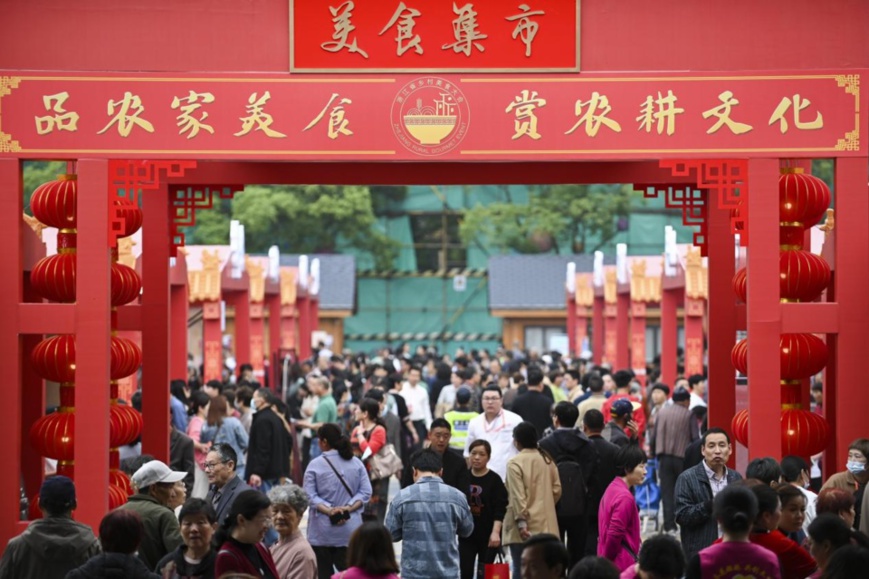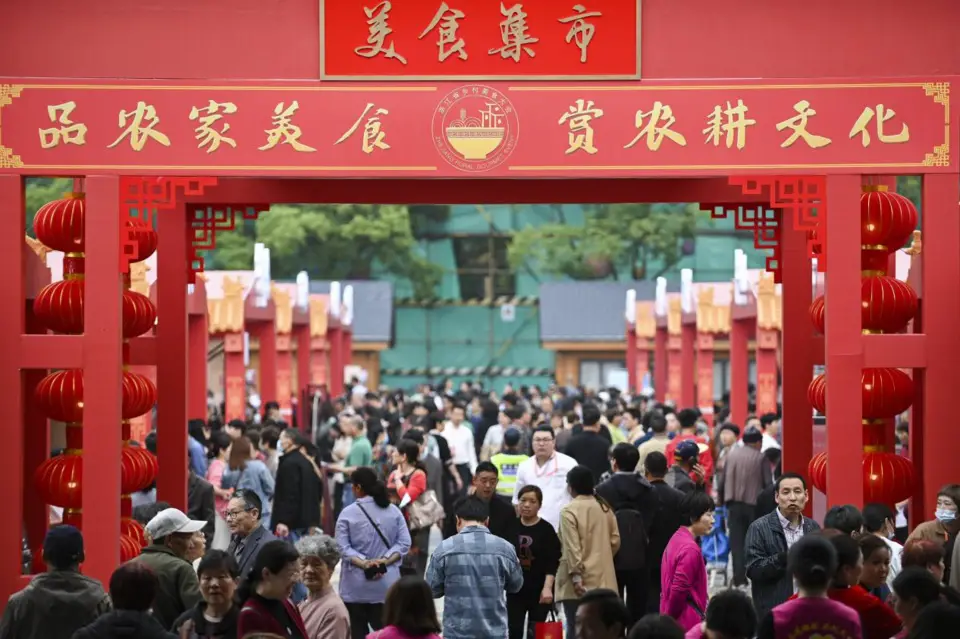By Du Haitao, Chang Qin, People’s Daily

Photo taken on April 28, 2021, shows tourists at a food fair in Jinhua city, east China’s Zhejiang province, during the province’s first countryside gourmet conference. (Photo by Hu Xiaofei/People’s Daily Online)
As his income has increased along with the booming local industries, Qiao Mingzhou, a villager in east China’s Shandong province, has bought a new-energy vehicle, which is parked near his electric tricycle in the neat and tidy yard of his home.
“My old electric tricycle can’t protect people from the wind and the rain, so I can’t use it to send my grandson to and pick him up from school in windy and rainy days,” said the resident in Hejia village, Niuzhuang township, Dongying city, Shandong.
Since China rolled out favorable policies to boost auto consumption and provided subsidies for new-energy vehicle buyers, he has bought the new car from a store in Niuzhuang township, Qiao added.
Niuzhuang is a major agricultural township. Its planting area of vegetables and fruits has continuously expanded, and the annual per capita disposable income of local farmers has exceeded 24,000 yuan ($3,766).
“Thanks to the increase of my income, I have gradually replaced my household appliances with more advanced ones,” Qiao said, referring to his new air conditioner, fully automatic washing machine, and other domestic appliances.
“We have purchased ‘a big thing’ this year. It is ultra-quiet and equipped with sterilization function,” he said, pointing at a cylindrical vertical air conditioner in his living room.
Multiple favorable policies launched by the Chinese government have driven the upgrading of farmers’ “shopping carts”.
The implementation of government policies that are aimed at boosting agriculture and benefiting farmers has improved villagers’ quality of life, noted Shen Qiong, dean of the economics department of the Business School of Zhengzhou University.
Almost each household in Hejia village owns a car, and the number of new-energy vehicles in the village has continuously increased. Hejia village is building charging piles to satisfy residents’ need, Qiao pointed out.
During the first 10 months of this year, the retail sales of consumer goods in rural areas of China reached 4,753.3 billion yuan, up 14.4 percent, according to China’s National Bureau of Statistics (NBS).
In October, the retail sales of consumer goods in rural areas rose 5.6 percent year on year, 0.8 percentage points higher than the increase in the retail sales of consumer goods in urban areas, data from the NBS shows.
As Chinese economy continues to recover steadily, China’s rural consumption has thrived and rural demands become vibrant, playing a more prominent role in stimulating economic growth.
China plans to improve the urban-rural integrated consumption network, promote e-commerce in more villages, optimize the county-level consumption environment, and facilitate the upgrading of rural consumption, according to the country’s Outline of the 14th Five-Year Plan (2021-2025) for National Economic and Social Development and the Long-Range Objectives Through the Year 2035.
Stimulating rural consumption and improving the scale and quality of consumption in counties and townships are not only an inevitable path to promoting rural revitalization in an all-round way, but an important link in tackling unbalanced and inadequate development and an objective requirement of advancing the realization of common prosperity, which bear great significance for smoothening domestic circulation and accelerating the construction of the country’s new “dual circulation” development paradigm.
China has more than 2,800 county-level administrative regions and more than 38,000 township-level administrative regions, with a large population in counties and townships.
Over the past few years, the total retail sales of consumer goods in China’s rural areas, the per capita consumption expenditure of rural residents, and online retail sales in rural areas have all maintained rapid growth. Meanwhile, products representing consumption upgrading, including automobiles, home appliances, digital products, and beauty products, and service consumption have shown great room for growth.
China’s rural market still has huge room for improvement. In some villages, the underdeveloped commercial facilities, monotonous products, and service models that are relatively backward are restricting the improvement in rural residents’ consumption level.
Besides, farmers in the countryside covering a vast area are scattered, which makes the “last mile” of delivery services still a head-scratcher.
It is necessary to accelerate innovation and improvement in service models and stimulate consumption vitality to further promote the expansion and upgrading of the rural market.
The rural market is considered a blue ocean and emerging market with huge consumption potential. It is believed that with the continuous improvement in infrastructure, increasing high-quality supplies, and rural household consumption upgrading, the vitality of Chinese rural market will surely be continuously stimulated, thus injecting stronger impetus into the sustained and healthy development of the economy.
“My old electric tricycle can’t protect people from the wind and the rain, so I can’t use it to send my grandson to and pick him up from school in windy and rainy days,” said the resident in Hejia village, Niuzhuang township, Dongying city, Shandong.
Since China rolled out favorable policies to boost auto consumption and provided subsidies for new-energy vehicle buyers, he has bought the new car from a store in Niuzhuang township, Qiao added.
Niuzhuang is a major agricultural township. Its planting area of vegetables and fruits has continuously expanded, and the annual per capita disposable income of local farmers has exceeded 24,000 yuan ($3,766).
“Thanks to the increase of my income, I have gradually replaced my household appliances with more advanced ones,” Qiao said, referring to his new air conditioner, fully automatic washing machine, and other domestic appliances.
“We have purchased ‘a big thing’ this year. It is ultra-quiet and equipped with sterilization function,” he said, pointing at a cylindrical vertical air conditioner in his living room.
Multiple favorable policies launched by the Chinese government have driven the upgrading of farmers’ “shopping carts”.
The implementation of government policies that are aimed at boosting agriculture and benefiting farmers has improved villagers’ quality of life, noted Shen Qiong, dean of the economics department of the Business School of Zhengzhou University.
Almost each household in Hejia village owns a car, and the number of new-energy vehicles in the village has continuously increased. Hejia village is building charging piles to satisfy residents’ need, Qiao pointed out.
During the first 10 months of this year, the retail sales of consumer goods in rural areas of China reached 4,753.3 billion yuan, up 14.4 percent, according to China’s National Bureau of Statistics (NBS).
In October, the retail sales of consumer goods in rural areas rose 5.6 percent year on year, 0.8 percentage points higher than the increase in the retail sales of consumer goods in urban areas, data from the NBS shows.
As Chinese economy continues to recover steadily, China’s rural consumption has thrived and rural demands become vibrant, playing a more prominent role in stimulating economic growth.
China plans to improve the urban-rural integrated consumption network, promote e-commerce in more villages, optimize the county-level consumption environment, and facilitate the upgrading of rural consumption, according to the country’s Outline of the 14th Five-Year Plan (2021-2025) for National Economic and Social Development and the Long-Range Objectives Through the Year 2035.
Stimulating rural consumption and improving the scale and quality of consumption in counties and townships are not only an inevitable path to promoting rural revitalization in an all-round way, but an important link in tackling unbalanced and inadequate development and an objective requirement of advancing the realization of common prosperity, which bear great significance for smoothening domestic circulation and accelerating the construction of the country’s new “dual circulation” development paradigm.
China has more than 2,800 county-level administrative regions and more than 38,000 township-level administrative regions, with a large population in counties and townships.
Over the past few years, the total retail sales of consumer goods in China’s rural areas, the per capita consumption expenditure of rural residents, and online retail sales in rural areas have all maintained rapid growth. Meanwhile, products representing consumption upgrading, including automobiles, home appliances, digital products, and beauty products, and service consumption have shown great room for growth.
China’s rural market still has huge room for improvement. In some villages, the underdeveloped commercial facilities, monotonous products, and service models that are relatively backward are restricting the improvement in rural residents’ consumption level.
Besides, farmers in the countryside covering a vast area are scattered, which makes the “last mile” of delivery services still a head-scratcher.
It is necessary to accelerate innovation and improvement in service models and stimulate consumption vitality to further promote the expansion and upgrading of the rural market.
The rural market is considered a blue ocean and emerging market with huge consumption potential. It is believed that with the continuous improvement in infrastructure, increasing high-quality supplies, and rural household consumption upgrading, the vitality of Chinese rural market will surely be continuously stimulated, thus injecting stronger impetus into the sustained and healthy development of the economy.
 Menu
Menu
 Rural consumption thrives as farmers’ income grows in China
Rural consumption thrives as farmers’ income grows in China
















